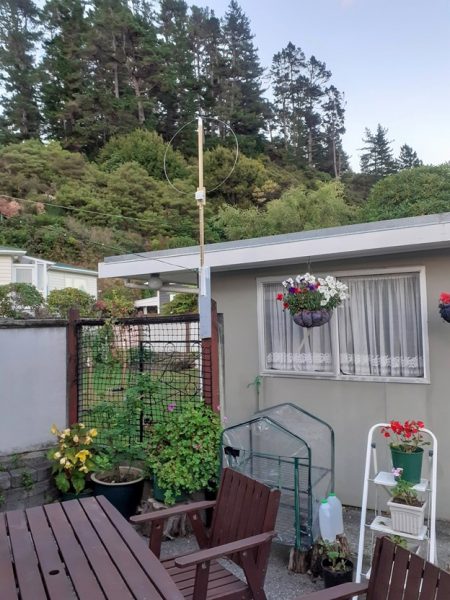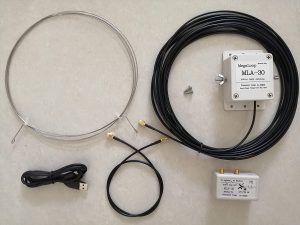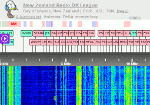By Ken Baird
After watching many recent reviews of this antenna, which covers the frequency range 0.5 to 30 MHz, and was highly recommended by the “OfficialSWLChannel” on Youtube, I decided to get one from China via eBay for $NZ75 shipping included. This price is exceptional compared to $US450 for the US version. The English version is about £400+. Very prompt delivery, well packed, and assembled and erected in 30 minutes. A very low profile stainless high tensile steel wire (piano wire?) loop 1.1m in diameter, and fully water-proof mast mounted amplifier connected by 10m of receiving coax to the bias-tee power feed and then to radio using sma connectors. The masthead amp is remotely powered by a standard 5V USB supply via the bias-tee. I tried using a 12v power supply via the bias-tee but no improvement was apparent. The mast head amp has adjustable gain, but is factory set to mid range. All components are fully epoxy encapsulated and there is no external join in the coax – it is waterproof. Some owners have installed a bnc connector on the outside of the amplifier to use heavy duty coax, and have replaced the wire loop with copper tubing. My experience to date does not indicate the need for this as the performance of this receive only antenna is excellent as is. A report from a Canadian user indicated his standard MLA went through a Canadian winter with no problems at all – it is rugged. However, I have fed the receiving coax into my study supported by a strong messenger wire to avoid any breakages. A recent video compared the original MLA-30 with the MLA-30+ the MLA-30+ has been improved over the original MLA-30. LW & MW performance has been improved significantly – the 30+ could pick up stations not audible with the 30. SW performance up to 11MHz has not been altered, but higher than 11MHz, a significant improvement was noticed on the receiver s-meter. The only version now available is the MLA-30+.

I have over the last few days compared the performance of the MLA to my NZRDXL Coax Loop and 10m wire.
COAX LOOP – MLA
Up to about 12MHz the coax loop and MLA are very similar, with the MLA being easier to use as it does not require continuous tuning across the sw band of interest. Both very quiet and sensitive. However, the MLA works very well up to 30MHz. The upper limit of my coax loop is 12 MHz. The coax loop is better on MW as the MLA is weak in that area. The MLA is not the best antenna for MW Dxers but very good for SW Dxers. Both the Coax loop and MLA cover the SW bands I am interested in (60m – 31m). But the coax loop can peak required signals and null out interfering signals, being fixed in orientation the MLA can’t.
10m WIRE – MLA
Compared to my 10m wire the MLA is quieter and more sensitive. The wire and MLA are mounted at right angles to each other to give me full 360 degrees coverage. I was testing the MLA on the 31m band one morning and wandered onto 10MHz, WWH booming in, louder than I have ever heard before. WWH was weak in the background. The same for 5MHz. In the afternoon I checked 15 MHz with the same results. My 10m wire had weak reception only. This was common across all SW bands. The MLA was much better than my wire.
Since installing the MLA on the 25/2, I have made some 90 loggings using it from 02:00-04:00, 06:00-08:00, 22:00-23:00 UTC over the last 7 days with frequencies from 4840kHz to 17810kHz with no evidence of overloading or noise. I use SDR2 to check band activity – 15 & 13m bands dead as usual. I am finding the MLA to be the best antenna I have used for SWL. It is ideal for my urban location as it has a very low profile with low noise pickup, and it would be ideal for a member on a very small site, as it is becoming increasingly more prevalent these days.
In summary, the MLA-30+ is a low priced, sensitive, rugged, low noise, wide band antenna suitable for urban areas and is now used by many SWLs worldwide.
I can recommend this antenna to the NZRDXL Members. As far as antennas are concerned, the MLA-30+ is the best bang for my buck I have found anywhere.
Ken Baird




